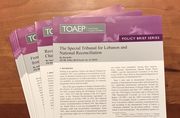Table of contents:
Element:
Prosecutor v. Radovan Karadžić, Case No. IT-95-5/18-T, Public Redacted Version of Judgement Issued on 24 March 2016 – Volume I of IV (TC), 24 March 2016, paras. 488-491:
"488. The elements of deportation and forcible transfer are substantially similar. Deportation and forcible transfer are defined as: (i) the forced displacement of one or more persons by expulsion or other forms of coercion, (ii) from an area in which they are lawfully present, (iii) without grounds permitted under international law. There is an important distinction between the two crimes; for deportation, the displacement of persons must be across a de jure border between two states or, in certain circumstances, a de facto border, and for forcible transfer, the removal may take place within national boundaries."
"489. To establish deportation and forcible transfer, there must be a forced displacement of persons carried out by expulsion or other forms of coercion. The term “forced” may include physical force, as well as the threat of force or coercion, such as that caused by fear of violence, duress, detention, psychological oppression, or abuse of power, or the act of taking advantage of a coercive environment. The forced character of the displacement is determined by the absence of genuine choice by the victim in his or her displacement. As such, while persons may consent to, or even request, their removal, any consent or request to be displaced must be given voluntarily and as a result of the individual’s free will, assessed in light of the surrounding circumstances of the particular case."
"490. Furthermore, the involvement of a non-governmental organisation in facilitating displacements does not in and of itself render lawful an otherwise unlawful transfer. An agreement among military commanders, political leaders, or other representatives of the parties in a conflict cannot make a displacement lawful either; it is the consent of the individual that determines whether a displacement is voluntary."
"491. As stated above, an element of deportation and forcible transfer is that the victim must be “lawfully present” in the area from which the forced displacement takes place. In analysing this element of deportation and forcible transfer, the terms “lawfully present” should be given their common meaning and should not be equated to the legal concept of lawful residence."
6.1.2. Evidence of the lawful presence of nationals of the area from which they were deported.







